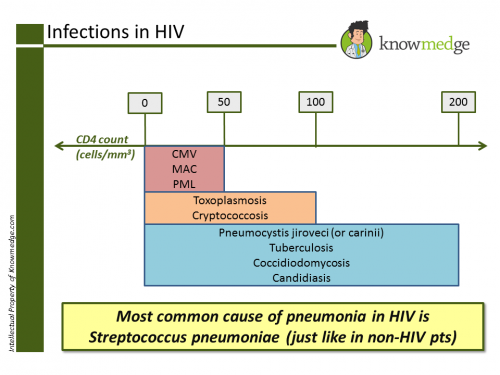HIV is an important topic to understand for the USMLE Step 3, ABIM, and on other medical exams where internal medicine is a major focus. The following is an excerpt out of Cracking the USMLE Step 3.
- Single stranded RNA retrovirus
- Check CD4 count and viral load to assess disease progression and degree of immunosuppression
- If CD4 count less than 200, beware of:
- Pneumocystis carinii pneumonia (PCP)
- Place patient on trimethoprim-sulfamethoxazole (i.e., Bactrim) for prophylaxis
- Tuberculosis (TB)
- Coccidiomycosis
- Candidiasis
- Pneumocystis carinii pneumonia (PCP)
- If CD4 count less than 100, beware of:
- Toxoplasmosis
- Cryptococcosis
- If CD4 count less than 50, beware of:
- Cytomegalovirus (CMV) infection
- Mycobacterium avium intracellulare (MAC) infection
- Cause of watery diarrhea in HIV patients
- Diagnose by finding acid fast bacilli in stool
- Place patient on azithromycin or clarithromycin for prophylaxis
- Progressive multifocal leuokoencephalopathy (PML)
- Caused by JC virus normally residing in the kidneys
- Causes white matter destruction of the brain
- LP shows aseptic meningitis
- Diagnose with brain biopsy
- Poor prognosis
- Other complications include:
- Kaposi sarcoma
- Most common cancer seen in HIV patients
- Almost seen exclusively in homosexual men with acquired immunodeficiency syndrome (AIDS)
- Caused by HHV-8
- Purple maculopapular rash that is usually localized
- Clinical diagnosis with biopsy
- Treat with chemotherapy and radiation
- Pneumonia
- Most common cause of pneumonia in HIV patients is Streptococcus pneumoniae
- AIDS dementia at end stage
- Kaposi sarcoma
- HIV can progress to AIDS
- Look for AIDS-defining illnesses
- Includes all diseases noted above
- Begin treatment for HIV/AIDS when patient’s CD4 count is 350 or less or with documentation of an AIDS-defining illness
- Treat with at least 3 medications to prevent resistance
- Highly active antiretroviral therapy (HAART) therapy includes nucleoside reverse transcriptase inhibitors, non-nucleoside reverse transcriptase inhibitors, and protease inhibitors
- Compliance is extremely important to prevent resistance
- If patient is HIV positive, physician has obligation to discuss with patient that they need to inform all their sexual partners who have been exposed of their HIV status as well as their current sexual partner
- Member of TORCH infections
- Transmitted transplacentally
- Place pregnant woman who is HIV positive on zidovudine starting at 14 weeks to prevent vertical transmission
- Place neonate on IV zidovudine after birth if concerned about exposure
- Indication for Cesarean section (C-section) if membranes are not yet ruptured or viral load is above 1000
- Can deliver vaginally if membranes are already ruptured and viral load is not high
- Breastfeeding is contraindicated

This blog was originally posted on the Knowmedge Blog.
No comments:
Post a Comment